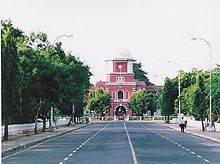
The main entrance of IIT Madras, showing its logo and its motto.
Tamil Nadu is the one of the most literate states in India. Tamil Nadu has performed reasonably well in terms of literacy growth during the decade 2001–2011. The state's literacy rate increased from 73.47% in 2001 to 80.3% in 2011 which is above the national average. A survey conducted by the Industry body Assocham ranks Tamil Nadu top among Indian states with about 100% Gross Enrollment Ratio (GER) in primary and upper primary education. One of the basic limitations for improvement in education in the state is the rate of absence of teachers in public schools, which at 21.4% is significant. The analysis of primary school education in the state by Pratham shows a low drop-off rate but poor quality of state education compared to other states.
Tamil Nadu has 37 universities, 454 engineering colleges. and 566 arts and science colleges, 34335 elementary schools, 5167 high schools, 5054 higher secondary schools and 5000 hospitals.Some of the most reputed educational institutes present in Tamil Nadu are University of Madras, IIT Madras, PSG College of Technology,Anna University Chennai, Coimbatore Institute of Technology, NIT Tiruchi, Madras Christian College, Christian Medical College, Bharathidasan Institute of Management,Madras Medical College, Loyola College and Tamil Nadu Agricultural University. The Indian Institute of Management is scheduled to open in Trichy by 2009–2010. Tamil Nadu produces the highest number of engineering graduates in India (around 1,75,000) every year which attracts many software companies to set up their shop in south India.

The administrative building of National Institute of Technology, Tiruchirappalli with its clock tower.
India has a human development index calculated as 0.619, while the corresponding figure for Tamil Nadu is 0.736, placing it among the top states in the country.The life expectancy at birth for males is 65.2 years and for females it is 67.6 years. However, it has a high level of poverty especially in the rural areas. As of 2004–2005, the poverty line was set at  351.86/month for rural areas and
351.86/month for rural areas and  547.42/month for urban areas.Poverty in the state dropped from 51.7% in 1983 to 21.1% in 2001 For the period 2004–2005, the Trend in Incidence of Poverty in the state was 22.5% compared with the national figure of 27.5%. The World Bank is currently assisting the state in reducing poverty High drop-out and low completion of secondary schools continue to hinder the quality of training in the population. Other problems include class, gender, inter-district and urban-rural disparities. Based on URP – Consumption for the period 2004–2005, percentage of the state's population Below Poverty Line was 27.5%. The Oxford Poverty & Human Development Initiative ranks Tamil Nadu to have a Multidimensional Poverty Index of 0.141, which is in the level of Ghana among the developing countries.
547.42/month for urban areas.Poverty in the state dropped from 51.7% in 1983 to 21.1% in 2001 For the period 2004–2005, the Trend in Incidence of Poverty in the state was 22.5% compared with the national figure of 27.5%. The World Bank is currently assisting the state in reducing poverty High drop-out and low completion of secondary schools continue to hinder the quality of training in the population. Other problems include class, gender, inter-district and urban-rural disparities. Based on URP – Consumption for the period 2004–2005, percentage of the state's population Below Poverty Line was 27.5%. The Oxford Poverty & Human Development Initiative ranks Tamil Nadu to have a Multidimensional Poverty Index of 0.141, which is in the level of Ghana among the developing countries.
The Dravidian movement, which championed the causes of educating the people and eradicating superstitions, began in Tamil Nadu. In addition, it aims to uplift socially repressed deprived communities and drew considerable support from the middle classes for their efforts in this matter. The movement was committed to social justice which led to the expansion of reservationsfor the deprived communities. Tamil Nadu now has 69% reservation in educational institutions, the highest among all Indian states.
The Mid-day Meal Scheme program in Tamil Nadu, initiated by Kamaraj, was expanded considerably during the rule of the AIADMK in 1983. It feeds over a fifth of the state's population. Despite this, the state is among the 12 states in India that have alarming level of hunger according to the 2008 Global Hunger Index.`


No comments:
Post a Comment